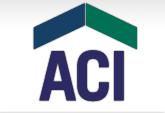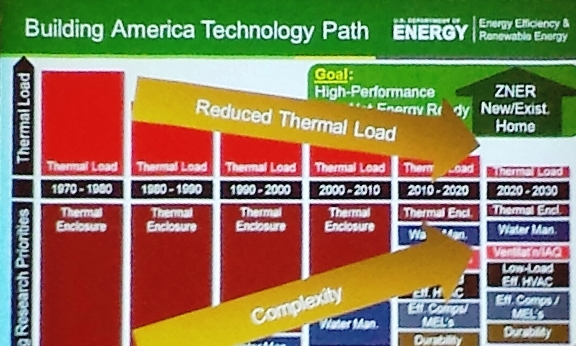 Late April & early May for me was filled up by conferences that included ACI National & a regional EEBA conference on Houses that Work. One of the sessions I attended at ACI was a shared presentation based on using ductless heat pumps (DHP) in cold climates & the 1000 home challenge. While this may sound like a strange pairing, it really wasn’t. This became even more apparent during EEBA’s daylong session that was filled with pictures of failed buildings emphasizing that no matter if you are building new or have an existing house, it is wise to do your homework & learn from others mistakes.
Late April & early May for me was filled up by conferences that included ACI National & a regional EEBA conference on Houses that Work. One of the sessions I attended at ACI was a shared presentation based on using ductless heat pumps (DHP) in cold climates & the 1000 home challenge. While this may sound like a strange pairing, it really wasn’t. This became even more apparent during EEBA’s daylong session that was filled with pictures of failed buildings emphasizing that no matter if you are building new or have an existing house, it is wise to do your homework & learn from others mistakes.
The first part of the ACI session was on a huge study & project in the Pacific Northwest where their primary heating was electric baseboards. While heat pumps have come a long way & there are units rated to produce heat at 0° or below… they did not make the mistake of thinking that in itself would be enough (please remember these are in older houses). In this study (which includes parts of Montana, Idaho, & mountainous regions in Washington and Oregon) they left the older electric baseboards in place as a secondary heat source which appears to have been a good thing as every single place ended up using them at one point or another. Overall, the program scored big on energy reductions & comfort with only a few exceptions, which based on the pictures were attributable to poor placement & installation of the units.
One of the key points made in the “Houses that work” seminar is that a comprehensive systems & process based approach using sound building science is required. Why? Well as the slide below demonstrates, the more we work on reducing the loads in a house, the more complex it gets. The more complex we get, the more the chances of errors increase which means, we can end up trapping more moisture in areas we don’t want it. To cap it off, the reduced heat loss diminishes the chances that it will ever dry out.

So how do we prevent that?
 The first thing to remember is that the whole house is a system so if you change one item, it affects other items. While certain parts might be easily changed out or added like the DHP’s above, you need to know what the limitations are. One of my favorite examples is – you wouldn’t drop a Ferrari engine in a Yugo & expect the car to perform like one, would you? Well the same is true of your house. In order to create a truly high performance house you should consider all the items to get there & in the proper order.
The first thing to remember is that the whole house is a system so if you change one item, it affects other items. While certain parts might be easily changed out or added like the DHP’s above, you need to know what the limitations are. One of my favorite examples is – you wouldn’t drop a Ferrari engine in a Yugo & expect the car to perform like one, would you? Well the same is true of your house. In order to create a truly high performance house you should consider all the items to get there & in the proper order.
-
The low hanging fruit
- Appliances, lights, and other more efficient items can be swapped out at any time
- Having said that, it makes no sense to blow your budget on new high-end equipment if you are pushing other items back. It is akin to redoing your kitchen knowing you have a roof leak
- Tight Construction
- Moisture control – As mentioned in another piece, if you can’t keep water out trying to stop air infiltration (and everything else) is meaningless
- Air Control – once you have dealt with moisture, air is next not only because it can transport said moisture, but also makes other changes meaningless (remember the line about are you trying to cool off the outdoors if you left the door open? Well the same applies on a smaller scale when it comes to your house)
- Insulation
- Increased R-Value – during winter time most people throw on thicker blankets to help hold the heat in, same applies to your house
- Proper installation – using the example above, if the blanket doesn’t fully cover you, you are not going to be comfortable are you?
- Ventilation
- No houses do not need to breathe but people do bringing me to my favorite quote by Michael Anschel on this; “Dead or sick customers don’t make good referrals”
- Bathrooms & Kitchens need properly installed, functioning, & used exhaust fans
- Efficient Water Heater
- Atmospheric vented appliances have no business being inside a house as all the items you just addressed above are not only being short circuited by this one appliance, but you are also putting you & you’re family at risk
- Efficient HVAC systems
- Having taken care of the above now you can consider buying the most efficient system you can which in many cases will be half the size if not more that was required or used before
- Don’t forget the ducts also count as it doesn’t matter if you condition the air, if it doesn’t get to where it is needed
- Last but not least – after you have done the above you can start to seriously look into solar or other renewable energy sources.
Other Guiding Principles:
 Tying this all together was Linda Wigington who heads up the 1000 Home Challenge which focuses on what many like to refer to as Deep Energy Retrofits (DER). In this case, the goal is to get 1000 or more homes and homeowners to reduce their energy use by 70%. One reason why they have been so successful is they use items like the DHP, they focus on the items above, and they do case studies on what worked & what they could do better. One other reason is they know that very few people can do all that is needed in one fell swoop so they allow for phased or staged approaches. With that, here is her 7 guiding principles based on lessons learned for staged approaches to deep reductions.
Tying this all together was Linda Wigington who heads up the 1000 Home Challenge which focuses on what many like to refer to as Deep Energy Retrofits (DER). In this case, the goal is to get 1000 or more homes and homeowners to reduce their energy use by 70%. One reason why they have been so successful is they use items like the DHP, they focus on the items above, and they do case studies on what worked & what they could do better. One other reason is they know that very few people can do all that is needed in one fell swoop so they allow for phased or staged approaches. With that, here is her 7 guiding principles based on lessons learned for staged approaches to deep reductions.
- Start with the “end in mind” & examine the steps that are required. By planning ahead you can minimize or eliminate barriers to future phases
- Consider the Whole Value Proposition – in many cases the “efficiency savings” are just a small portion but the comfort & safety values are huge. In many cases I liken the savings as just being the cherry on top
- Do No Harm aka the House is a System – make sure you recognize potential issues (like the Water Heater mentioned above) & address how you are going to handle them (1000 Home Challenge Worksheet)
- Consider creative approaches such as equipment leases or how you can re-use or utilize some component later
- Avoid suboptimal investment & rework – Do each step right the first time, it makes no sense to rip something out that you have already done later. She also brings up a good point that structural changes will usually last longer than mechanical ones so getting it right there pays off (Example of steps by my friend Josh who is doing this to his own house on Sym-Home.net)
- Consider clusters of work by trade in order to reduce costs – i.e. would you rather have the electrician out three times & pulling three different permits or just once? A little foresight goes a long way
- Make sure the systems or components you choose will work well over a wide range of conditions like how things are now & how they will be in the future.
